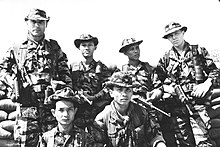What is the name of the city that used to be named Saigon? Is it in a democracy or a communist country?
You Democrats were in power when Viet Nam was abandoned to the communists.[/QUOTE]
ARVN taking the lead and U.S. ground-force withdrawal
Vietnam War - Wikipedia

ARVN and US Special Forces, September 1968
Beginning in 1970, American troops were withdrawn from border areas where most of the fighting took place and instead redeployed along the coast and interior. US casualties in 1970 were less than half of 1969 casualties after being relegated to less active combat.
[258] At the same time that US forces were redeployed, the ARVN took over combat operations throughout the country, with casualties double US casualties in 1969, and more than triple US ones in 1970.
[259] In the post-Tet environment, membership in the
South Vietnamese Regional Force and
Popular Force militias grew, and they were now more capable of providing village security, which the Americans had not accomplished under Westmoreland.
[260] In 1970 Nixon announced the withdrawal of an additional 150,000 American troops, reducing the number of Americans to 265,500.[258] By 1970 Viet Cong forces were no longer southern-majority, as nearly 70% of units were northerners.[261] Between 1969 and 1971 the Viet Cong and some NVA units had reverted to small unit tactics typical of 1967 and prior instead of nationwide grand offensives.[240] In 1971 Australia and New Zealand withdrew their soldiers, and U.S. troop count was further reduced to 196,700, with a deadline to remove another 45,000 troops by February 1972. The United States also reduced support troops, and in March 1971 the 5th Special Forces Group, the first American unit deployed to South Vietnam, withdrew to Fort Bragg, North Carolina.[262][A 5]
Fall of Saigon
Main article:
Fall of Saigon
Further information:
Operation Frequent Wind

Victorious NVA troops at the Presidential Palace, Saigon
Chaos, unrest, and panic broke out as hysterical South Vietnamese officials and civilians scrambled to leave Saigon.
Martial law was declared. American helicopters began evacuating South Vietnamese, U.S., and foreign nationals from various parts of the city and from the U.S. embassy compound.
Operation Frequent Wind had been delayed until the last possible moment, because of U.S. Ambassador
Graham Martin's belief that Saigon could be held and that a political settlement could be reached.

Reunification parade following the Fall of Saigon, with the city being renamed
Ho Chi Minh City
Schlesinger announced early in the morning of 29 April 1975 the evacuation from Saigon by helicopter of the last U.S. diplomatic, military, and civilian personnel. Frequent Wind was arguably the largest helicopter evacuation in history. It began on 29 April, in an atmosphere of desperation, as hysterical crowds of Vietnamese vied for limited space. Martin pleaded with Washington to dispatch $700 million in emergency aid to bolster the regime and help it mobilize fresh military reserves, but American public opinion had soured on the conflict.
President
Gerald Ford had given a televised speech on 23 April, declaring an end to the Vietnam War and all U.S. aid. Frequent Wind continued around the clock, as North Vietnamese tanks breached defenses on the outskirts of Saigon. In the early morning hours of 30 April, the last U.S. Marines evacuated the embassy by helicopter, as civilians swamped the perimeter and poured into the grounds. Many of them had been employed by the Americans and were left to their fate.
On 30 April 1975, NVA troops entered the city of Saigon and quickly overcame all resistance, capturing key buildings and installations. A tank from the 324th Division crashed through the gates of the
Independence Palace at 11:30 am local time and the Viet Cong flag was raised above it. President
Dương Văn Minh, who had succeeded Huong two days earlier, surrendered to Colonel
Bùi Tín.
[284]
****************************************************************************************************
In December 1973, two months after the resignation of Spiro Agnew, Ford became the first person appointed to the vice presidency under the terms of the 25th Amendment by President Richard Nixon. After the subsequent resignation of President Nixon in August 1974, Ford immediately assumed the presidency. His 895 day-long presidency is the shortest in U.S. history for any president who did not die in office.


